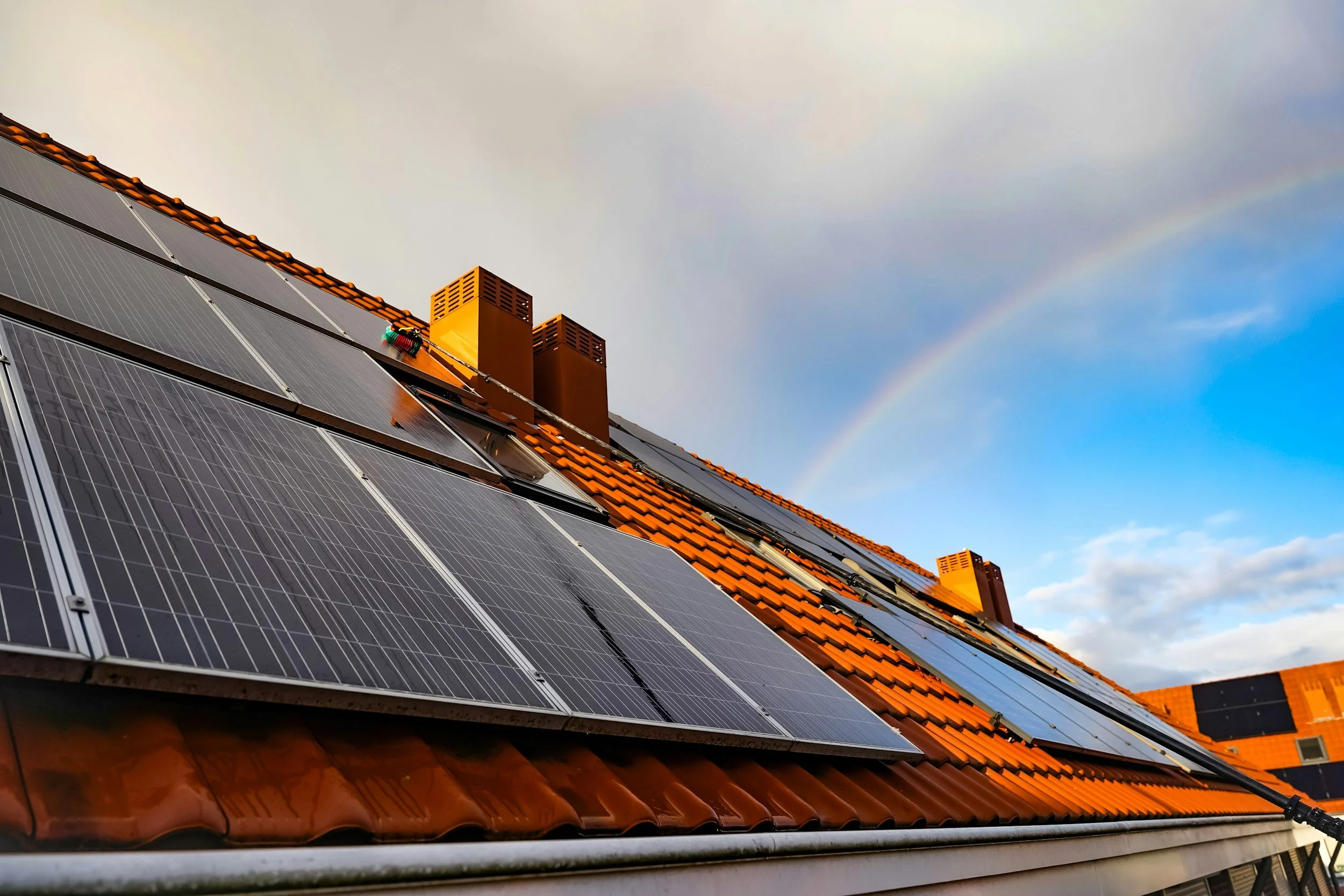Blog By: Sam Hilgeman
While the Bluegrass State has been relatively late to the residential solar trend, it has started to catch up at just the wrong time. In 2015, 0% of the energy consumed by Kentucky came from solar energy; in 2024, 0.5% of the energy consumed by Kentucky came from solar energy.[i] Just as solar energy began to gain a toehold in Kentucky over the last few years, Congress enacted the One Big Beautiful Bill Act (“BBB”) on July 4, 2025.[ii]
While the bill encompassed many different policy objectives, it will have a particularly detrimental impact on residential solar energy.[iii] Prior to the enactment of the BBB, homeowners receive a tax credit, the Residential Clean Energy Credit, for costs incurred for the installation of solar panels on their homes.[iv] Homeowners could receive a tax credit for 30% of those costs; if, for example, a homeowner installed $10,000 worth of solar panels, they would receive a $3,000 tax credit.[v] Under the BBB legislation, however, these credits will phase out at the end of the year, and any solar panels installed after December 31, 2025 will be ineligible for the credit.[vi]
Prior to BBB’s passage, green energy advocates in the Commonwealth warned that it would have a negative impact on the growth of solar energy in a state that was already behind.[vii] CEO of Commonwealth Solar, Daniel Weir, expressed concern that the tax credit phase out would have a “chilling effect” on the residential market because homeowners will have a lesser incentive to install solar panels on their homes.[viii]
The impact Weir warned of will especially be felt over a longer period of time unless the state can provide its own solar incentives. The impact of BBB will have a negligible short-term impact on solar energy in Kentucky. Only households who cannot afford to shell out roughly $20,000[ix] for installation costs without some immediate benefit will feel the impact of BBB.
Because solar panel installation has a relatively high upfront cost, very few homes in Kentucky have installed them; in 2024, only 5,350 homes in the state had solar panels.[x] Kentucky homes that do have solar panels are typically high-income households; 54% of all solar panel owners have household incomes greater than $100,000.[xi]
High-income households will still have an incentive to install solar panels because they will be able to recoup the cost in the value it brings to their homes in the form of reduced power bills and increased home value. When homeowners with solar panels sell their homes, buyers have been willing to pay a $15,000 market premium for an average-size solar energy system.[xii] Additionally, those homes can save money on their utility bills; while the exact savings differ from home to home, the average Kentucky home can save $42,000 in utility costs over a 25-year span by installing solar panels.[xiii] Compared to the 30% tax credit under the previous regime, the market premium provides a larger monetary benefit, but the tax credit comes immediately after installation.[xiv] Homeowners that cannot afford to wait until the sale of their home to receive some return on the solar panels will have little incentive to do so after the tax credits phase out.
Over an extended period, Kentucky will fall behind other states who already have a strong foothold in residential solar energy. 41 states and the District of Columbia all have more households with solar energy than Kentucky.[xv] Even within the local region, Kentucky has fallen behind other states; Virginia has 44,954 homes with solar, Missouri has 19,700, Ohio has nearly 18,000, and Indiana has 9,022.[xvi]
Given that those states already have the infrastructure to add even more residential solar panels, the termination of the federal credit will have a disproportionate impact on Kentucky. Put simply, these states have already taken advantage of a tax credit that thousands of Kentucky homes will miss out on.[xvii]
In order to not fall behind other states, Kentucky should follow in the footsteps of New York who has provided its own state solar tax credit, the Solar Energy System Equipment Credit, since 2019.[xviii] Similar to the current federal tax credit, New York provides homeowners with a 25% tax credit on solar installation costs and is limited to $5,000 per household.[xix] This credit provides homeowners who do not have the financial means to cover the cost of solar installation with enough incentive to overcome the financial barrier of costly initial installation.[xx]
Without this credit, only high-income households would have been able to install solar panels, and New York would have fallen behind other states. New York, who now has 208,000 homes with solar panels, now ranks third among all states in the country for the number of residential solar, behind only California and Arizona.[xxi] If the Kentucky legislature does not find some replacement incentive for homeowners to install solar panels, then new installations will drop significantly, and Kentucky will continue to lag drastically behind other states in residential solar power production.
[i] Frontier Group, The State of Renewable Energy in Kentucky (Apr. 25, 2025), https://frontiergroup.org/wp-content/uploads/2025/04/Renewables-FS-Apr25_KY.pdf, [https://perma.cc/8PYQ-DKWK].
[ii] H.R. 1, 119th Cong. (2025).
[iii] Id.
[iv] Internal Revenue Service, Residential Clean Energy Credit, https://www.irs.gov/credits-deductions/residential-clean-energy-credit [https://perma.cc/FS7R-DUNK].
[v] Id.
[vi] Sarah Lozanova, Residential Solar Tax Credit Going Away in US After 2025, Green Lancer, (updated Oct. 3, 2025), https://www.greenlancer.com/post/solar-tax-credit-ending [https://perma.cc/57C8-HAA7].
[vii] Carlee Hogsten, Ky. Green energy advocates express concern over tax credit cuts in new energy bill, WKYT, (July 4, 2025), https://www.wkyt.com/2025/07/04/ky-green-energy-advocates-express-concern-over-tax-credit-cuts-new-bill [https://perma.cc/689Q-AV69].
[viii] Id.
[ix] Consumer Affairs, How much do solar panels cost in 2025? (updated July 28, 2025), https://www.consumeraffairs.com/solar-energy/how-much-do-solar-panels-cost.html/ [https://perma.cc/LJ7N-A44Z].
[x] SolarInsure, How Many Americans Have Solar Panels in 2024? (last visited Oct. 13, 2025), https://www.solarinsure.com/how-many-americans-have-solar-panels/ [https://perma.cc/M2VW-SPUT].
[xi] Galen Barbose, Residential Solar-Adopter Income and Demographic Trends: 2022 Update, Lawrence Berkely National Laboratory, (2022), https://eta-publications.lbl.gov/sites/default/files/solar-adopter_income_trends_final_0.pdf/ [https://perma.cc/PM77-HZ69].
[xii] Ben Hoen, Selling Into the Sun: Price Premium Analysis of a Multi-State Dataset of Solar Homes, Energy Markets & Policy Berkely Lab, (2015), https://emp.lbl.gov/publications/selling-sun-price-premium-analysis/ [https://perma.cc/XF57-MRZ2].
[xiii] Consumer Affairs, supra note 9.
[xiv] Internal Revenue Service, supra note 4.
[xv] SolarInsure, supra note 10.
[xvi] Id.
[xvii] Id.
[xviii] New York Department of Taxation and Finance, Solar Energy System Equipment Credit, (last visited Oct. 13, 2025), https://www.tax.ny.gov/pit/credits/solar_energy_system_equipment_credit.htm [https://perma.cc/XS2L-77LU].
[xix] Id.
[xx] Id.
[xxi] SolarInsure, supra note 10



